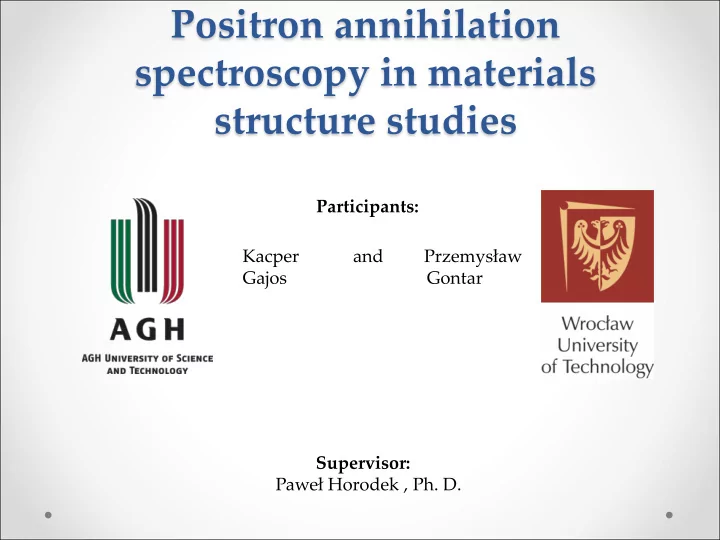

Positron annihilation spectroscopy in materials structure studies Participants: Kacper and Przemysław Gajos Gontar Supervisor: Paweł Horodek , Ph. D.
Outline • Basics of Positron Annihilation Spectroscopy (PAS) • Slow positron beam • Idea of measurements • Results • Summary
Basics of PAS POSITRON IS AN ANTIPARTICLE OF THE ELECTRON POSITRON SOURCES β + decay isotopes Two gamma quanta emission (511 keV) from the pair e + e - with momentum p annihilation. ANNIHILATION e + e - THE DEVIATION FROM COLINEARITY e + + e - → 2 (99.8 %, E ≈ 511 keV) INTERACTION elastic scattering CHANGING OF GAMMA QUANTA ENERGY nonelastic scattering as a result of the Doppler shift bremsstrahlung INSIDE THE MATTER implantation into medium thermalization diffusion annihilation with electron
Basics of PAS EXPERIMENTAL TECHNIQUES Doppler broadening of annihilation gamma line (DBGL) positron life times (LT) POSSIBILITIES defect concentration defect concentration profile detection of the kind and size of defects APPLICATIONS solid body physics material and surface engineering metals, semiconductors, thin layers The examples of structural defects. AIM OF THE EXERCISE Introduction to PAS. Measurement of S parameter profile for sample of Cu after milling
Slow positron beam SLOW POSITRON BEAM IS THE FLUX OF MONOENERGETIC PARTICLES WITH ENERGYS BETWEEN A FEW eV AND A FEW DOZENS keV TWO TYPES OF MODERATORS SCHEME OF THE POSITRON EMISSION SPECTRUM OF A 22 Na SOURCE FROZEN NEON TUNGSTEN FOIL
Slow positron beam (Low Energy Particle Toroidal Accumulator) moderator intensity energy range diameter of the vacuum flux conditions frozen Ne 3 [mm] (7 K)
Slow positron beam
Slow positron beam
Slow positron beam gamma ≈ 511 keV HpGe detector preamplifier amplifier MC analyzer PC computer The energy resolution of DBGL spectrometer at LEPTA project is 1.2 keV interpolated at 511 keV.
Idea of measurements S - PARAMETER 60000 defected non-defected 50000 40000 A S S = counts A 30000 A S 20000 A 10000 W- PARAMETER background A W 0 507 509 511 513 515 energy [keV] Comparison of annihilation lines for defected and nondefected samples. The rule of calculation of S- and W- A parameters. W W = A
Results 0.43 0.43 0.42 0.42 0.41 0.41 S parameter S parameter 0.40 0.40 0.39 0.39 L + =76.7(2.7) 0.38 0.38 0.37 0.37 0 10 20 30 40 0.005 0.010 0.015 0.020 Energy [keV] W parameter
Results AVERAGE DIFFUSION LENGTH VEPFIT program solves it to fit the model function to experimental data DEFECTS CONCENTRATION MEAN IMPLANTATION DEPTH From 1.96 Å for 50 eV up to 1.084 μm for 35 keV bulk (*)=117 [ps] - mean positron lifetime (*) 5 10 14 [s -1 ]-the trapping coefficient for vacancies in pure Cu L bulk (*)=121 [nm] - the positron diffusion length in the bulk * J.Dryzek et. al.., Tribol. Lett 11 , 29 (2001)
Summary • The measurements were performed correctly, the typical S – parameter profile was obtained • The domination of one kind of defect, probably vacancies was observed • The mean diffusion length equal about 77 nm, as well as defects concentration on the level 2.3 × 10 -5 are similar to the values obtained by other authors for copper after sliding under load of 1.5 N
Acknowledgement All workers from LEPTA facility, especially: Prof. Igor Meshkov, Ph.D. Paweł Horodek, Ph.D . Andrey Kobets, Ph.D. Organizers: Prof. Roman Zawodny, Ph.D. Władysław Chmielowski, Ph.D. Kinga Horodek
Thank you for attention !
Recommend
More recommend